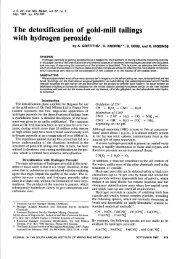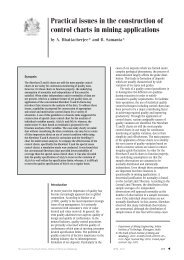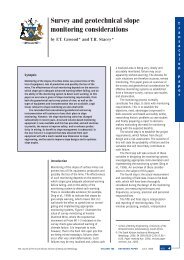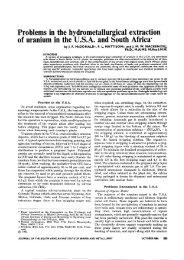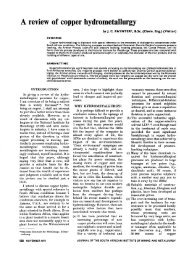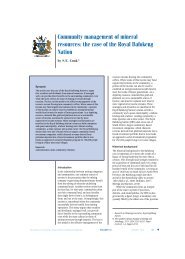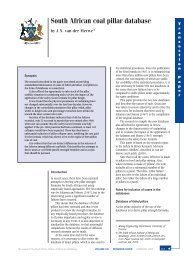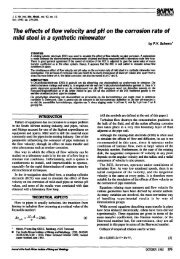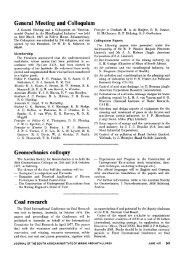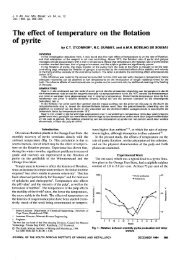The intensive cyanidation of gold-plant gravity concentrates - saimm
The intensive cyanidation of gold-plant gravity concentrates - saimm
The intensive cyanidation of gold-plant gravity concentrates - saimm
Create successful ePaper yourself
Turn your PDF publications into a flip-book with our unique Google optimized e-Paper software.
increase in the sodium cyanide addition from 30 to 70<br />
kgjt again increased the iron dissolution considerably.<br />
<strong>The</strong> copper dissolution again appeared to be unaffected<br />
by changes in reaction conditions.<br />
While the evidence presented for each type <strong>of</strong> agitator<br />
system is perhaps self evident, no definite conclusion<br />
can be drawn at this stage concerning the relative<br />
effectiveness <strong>of</strong> the flotation machine and the Superagitator,<br />
the only conclusive results being that the<br />
flotation machine gave lower residual values when using<br />
air than did the Super-agitator for short reaction times,<br />
indicating better aeration characteristics. It can reasonably<br />
be expected that, when optimum conditions are<br />
used, the flotation-machine system will yield residual<br />
<strong>gold</strong> values <strong>of</strong> between 10 and 20 gjt after relatively<br />
short reaction times. While the present exercise indicated<br />
very clearly that the type <strong>of</strong> agitation is an important<br />
operational parameter in the <strong>cyanidation</strong> <strong>of</strong><br />
<strong>gold</strong>-<strong>plant</strong> <strong>concentrates</strong>, further testwork on a larger<br />
scale would be required before the merits <strong>of</strong> the flotationmachine<br />
type <strong>of</strong> agitator can be evaluated.<br />
Effects <strong>of</strong> Temperature and Calcium<br />
It had been earlier established that both the<br />
liquid: solid ratio and the temperature <strong>of</strong> the pulp have<br />
a very direct bearing on the solubility <strong>of</strong> the aurocyanide<br />
complex during <strong>gold</strong> dissolution. Furthermore, the effects<br />
<strong>of</strong> calcium on such a leaching system and its effect on <strong>gold</strong><br />
solubility had yet to be established, and the significance<br />
<strong>of</strong> such reaction parameters had only been deduced by<br />
indirect means. Further investigation under actual<br />
leaching conditions was warranted.<br />
<strong>The</strong> investigation was thus primarily concerned with<br />
an elucidation <strong>of</strong> the effects <strong>of</strong> temperature and calcium<br />
on the kinetics <strong>of</strong> <strong>gold</strong> dissolution. <strong>The</strong> investigation was<br />
confined to the treatment <strong>of</strong> sample W4 (<strong>gold</strong> 19,4 kgjt)<br />
using the Super-agitator and the flotation-machine type <strong>of</strong><br />
agitator as previously described.<br />
For <strong>cyanidation</strong> carried out in the flotation-machine<br />
type <strong>of</strong> agitator, the experimental conditions and results<br />
are summarized in Table VIII, which shows the effects <strong>of</strong><br />
temperature on <strong>gold</strong> dissolution, together with the use<br />
<strong>of</strong> deionized water and <strong>of</strong> air and oxygen aeration.<br />
Likewise, Table IX shows the effect <strong>of</strong> temperature on<br />
<strong>gold</strong> dissolution in the presence <strong>of</strong> 0,28 gjl calcium added<br />
in the form <strong>of</strong> <strong>gold</strong>-<strong>plant</strong> mill return water. <strong>The</strong> above<br />
effects are also illustrated graphically in Fig. 6.<br />
It can readily be seen that, in both instances (Tables<br />
VIII and IX), temperature has a very important kinetic<br />
effect on the dissolution <strong>of</strong> <strong>gold</strong> at temperatures below<br />
20 QC. Gold extractions can be seen to decline considerably<br />
below 20QC, but were little affected in the range<br />
25 to 50 QC when oxygen aeration was used. However, the<br />
differences in the rate <strong>of</strong> reaction between air and oxygen<br />
were markedly lower at the higher reaction temperatures,<br />
sparging with air yielding residual <strong>gold</strong> values <strong>of</strong> 114<br />
gjt at 25 QC and 30 gjt at 45 QC after a contact time <strong>of</strong><br />
6 hours, which can be compared with 15 gjt at 25 QC and<br />
15 gjt at 45 QC using oxygen. <strong>The</strong> use <strong>of</strong> mill return<br />
water (Table IX) appeared to have no detrimental<br />
effect on the <strong>gold</strong> dissolution.<br />
When the experimental programme was repeated with<br />
~<br />
0<br />
~Eo<<br />
....<br />
C<br />
<<br />
IZ<<br />
0<br />
1'1<br />
~Eo<<br />
1'1<br />
Z<br />
=0<br />
~<br />
~<br />
p<br />
~ 1'1<br />
Eo<<br />
P=I<br />
< E-< ~<br />
1'1<br />
0<br />
Z<br />
0<br />
CQ<br />
~~<br />
I'< ::;::<br />
<<br />
0<br />
1'1<br />
~<br />
«>g<br />
~.~~<br />
,;.E~ ~~8ii~~g~~<br />
.S £ ~ ""' CQIN~ ~ooo




